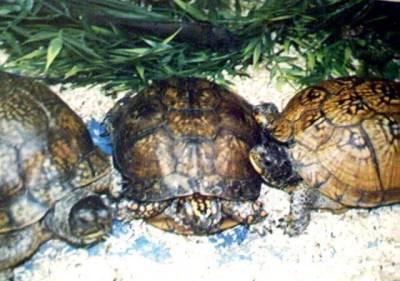Box Turtle - Gulf Coast
Scientific Name: Terrapene carolina major
Sat, 14th June, 2025 - 6:38 pm GMT
Sponsor Ads:

Alternative Name
Scientific Name: Terrapene carolina majorBasic Info
Gulf Coast Box Turtles have a hinged plastron (the underside of the shell), which enables them to shut their shell completely. The carapace of this turtle, or the top side of the shell, is very rounded. The shell is dark brown, as are the skin and the plastron. Adults sometimes lose their markings, but usually a faint pattern can be seen on the carapace. The Gulf Coast Box Turtle's jaw is slightly hooked. The toes are slightly webbed. They have four toes on the hind feet, with claws that tend to be shorter and thicker on males than females. Gulf Coast Box Turtles can grow to just over 6 inches in length.
Health
Ideally, the Gulf Coast Box Turtle should be kept at about 80 degrees during the day. They should also be provided with a basking area of between 90 and 95 degrees Fahrenheit. At night the temperature should be in the low 70s. Relative humidity levels should be around 65 percent. Indoor enclosures should be lit with full spectrum UV light for 12 or 13 hours per day. They like to soak in water, so they should have a shallow, easily accessible pool. The defecate in the water, so it will need to be changed frequently. Adult Gulf Coast Box Turtles should be fed 60-70% plant matter and 30-40% animal matter. They do well on a diet of leafy green vegetables and other plant matter such as tomatoes, green peppers, sweet potatoes, squash, cauliflower, berries, bananas, cherries, plums, and apple. Appropriate meaty items include crickets, earthworms, mealworms and canned low-fat dog food (a premium brand). They can also be fed commercial omnivore foods such as canned or pelleted box turtle food or primate biscuits softened in water. Breeding Gulf Coast Box Turtles mate between the beginning of spring and October. One successful mating can result in the female laying fertile eggs for up to four years. The females lay clutches of between 3 and 8 eggs between May and July in nests they build in sand or soil. The eggs hatch after about three months of incubation. The temperature the eggs are incubated at determines the sex. Incubation temperatures of 27 degrees Celsius or lower result in mostly male turtles, while temperatures above 28 degrees Celsius result in mostly females.Habitat
Found from the Florida panhandle along the coast of the Gulf of Mexico to TexasBehavior
The Gulf Coast Box Turtle is a small to moderately sized turtle, but it is the largest species of box turtle. They are very common as pets. Gulf Coast Box Turtles can usually be found near sources of water. The young usually hunt in water, while the adults forage more on land. Although it is a diurnal animal, meaning it is active during the day, in hot weather the Gulf Coast Box Turtle usually does not venture out except in the morning or after heavy rains. Instead, they hide under logs or leaves, in mud or other animal's burrows, or soak in pools and puddles. In more moderate weather, like spring and fall, the Gulf Coast Box Turtle often basks in the sun. At night, they sleep in shallow scrapes. At the northern edges of their very wide range, the Gulf Coast Box Turtle hibernates starting in October or November. Southern turtles wait until later in the year to hibernate. The turtles hibernate in mud, stream bottoms, holes in stumps, or mammal's burrows, usually around two feet under. They often hibernate in the same place every year and will sometimes hibernate in groups. The Gulf Coast Box Turtle becomes active again in April. The Gulf Coast Box Turtle usually does not range more than 250 yards. When threatened or frightened, the timid Gulf Coast Box Turtle retreats into its shell and clamps it shut. The Gulf Coast Box Turtle can be found in meadows, woodlands, and pastures.Origin
North AmericaHistory
The Gulf Coast Box Turtle can be found from the Florida panhandle along the coast of the Gulf of Mexico to Texas. Box Turtles are beneficial to humans because they eat pests like insects and distribute berry seeds around their range.Common Foods
The Gulf Coast Box Turtle is omnivorous. They feed on snails, berries, insects, fungi, worms, slugs, flowers, roots, frogs, fish, and salamanders. They will also eat carrion including dead amphibians, ducks, or mammals.Sponsor Ads:
"The life of money-making is one undertaken under compulsion, and wealth is evidently not the good we are seeking; for it is merely useful and for the sake of something else." -- Aristotle. Nicomachean Ethics.(I.1096a5). c. 325 BC.
Box Turtle - Gulf Coast
Coded by: BGID® | ALL RIGHTS RESERVED Copyright © 2000-2025
Disclaimer | Privacy | Report Errors / Contact | Credits
















